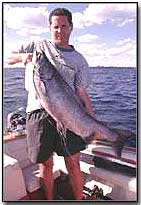Dodgers and August Kings
Dodgers and August Kings
How many times have you experienced a wild flurry of chinook action at dawn, only to have it die as morning wears on? You change lures, colours, depths, and speeds, but nothing helps. Yet, the sonar constantly marks big fish. You're in for a long, unproductive day unless you can find something to attract their attention and trigger strikes. Try dodgers. Popular during Lake Ontario's coho hey-day, they've since taken a back seat to new spoons and plugs. This is unfortunate, since under the right circumstances, they're big-king medicine.
Dodgers are rarely used to hunt for salmon. You must troll slowly, consequently you don't cover a lot of water. They're at their best when you know where the fish are, but refuse to hit. They're especially effective on staging late-summer and fall rivermouth chinook, which are driven by the spawning urge, rather than by appetite. The flashing, slashing, tumbling action of a dodger, mated with the erratic motion it imparts to a small rubber squid, streamer fly, or other lure behind it, is often more than an irritable king can stand. Dodgers are also dynamite attractors for lethargic chinooks resting in deep water during a hot summer day.
Here are the basics you'll need to know to become an artful dodger angler. Leads from downrigger releases to dodgers can be any length from 5 to 50 feet (1.5 to 15 m). The shorter the lead, the more erratic the action of the dodger and the lure. Sometimes the powerful, slashing action of a 10-foot (3 m) lead will drive kings crazy. Another day, the slow-moving, gentle wobble of a 25-foot (7.6 m) lead is more to their liking. Most anglers start short and lengthen as necessary.
Also affecting the action of your bait is the distance it trails behind the dodger. Without a dodger, squids and flies are dead in the water. Again, a short lead produces a more intense darting action, while a longer one results in a subtle swimming movement. Squids and flies come with pre-tied leaders, which in some cases are too long. As a guideline, most dodger manufacturers recommend a lead one-and-a-half times the length of the dodger.
 Small, light spoons and plugs are also effective behind a dodger. Use a 30- to 40-pound monofilament leader to reduce the chances of a breakoff from a king's sharp teeth. Start with a 36-inch (.9 m) leader and make downward adjustments until the lure has the desired action. I upgrade hook size on small spoons and plugs. They're often too small or too light to hook and hold a big chinook.
Small, light spoons and plugs are also effective behind a dodger. Use a 30- to 40-pound monofilament leader to reduce the chances of a breakoff from a king's sharp teeth. Start with a 36-inch (.9 m) leader and make downward adjustments until the lure has the desired action. I upgrade hook size on small spoons and plugs. They're often too small or too light to hook and hold a big chinook.
The most critical factor is trolling speed. Compared with most other chinook hardware, a dodger must be trolled slowly - 1.5 to 2 mph. Trolling too quickly causes it to spin, rather than wobble. Going too slowly eliminates pulsating movement. To determine the correct speed, put the dodger overboard and let out a few feet of line. Watch the dodger and then correct your speed until you see and feel a side-to-side whipping action. In addition to the dodger's speed, also check the action of lures behind them or on other lines. The biggest mistake anglers can make is to combine dodgers with lures that function properly only at higher speeds. As with all set-ups, experiment until you find a winning combination.
Dodgers come in a wide range of sizes and colours. Size "0" has been a workhouse for me, as well as many charter-boat operators. Chrome is my hottest colour, followed by mother-of-pearl, reds, and greens. Glo-in-the-dark shades are good in low-light conditions below 50 feet (15 m).
I haven't abandoned stand-alone chinook lures. Dodgers can be a pain. Their weight and drag require heavy line and dampen the fight of a fish. Tangles and cross-overs are common, unless you make wide turns. They're seldom used every day, but when you're boating fish and other anglers aren't, you'll be glad you had a few on board.
This article is written with permission by Fish Ontario. Visit their website, http://www.fishontario.com, for more Ontario fishing information.
Fish Ontario
|
